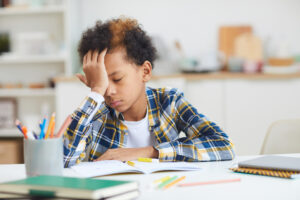Back to School Sleep Tips
Parents know that quality sleep is essential to their children’s success at school. With quality sleep, children have improved mood and ability to focus. Sleep is also essential for forming and retaining memories — an important part of learning!
But how can parents help their children get back on a sleep schedule for school after summer or holiday breaks? The secret lies in having healthy sleep habits year-round. A regular sleep schedule, as well as a quality sleep environment and other habits of good sleep hygiene, contribute to children’s academic achievements and overall well-being.
The Importance of Setting a Sleep Schedule
Children look to their parents for guidance on healthy habits. Sleep should be no exception. For both adults and children, a regular sleep schedule helps the body know when it’s time to sleep and wake up. A sleep schedule helps prevent fatigue, exhaustion, and daytime drowsiness.
Children and adolescents whose parents set a bedtime schedule are more likely to get sufficient sleep . These students likely have earlier bedtimes than their peers without parent-set bedtimes . Students with parent-set bedtimes also experience less fatigue during the day and less difficulty staying awake during the day.
How Much Sleep Does Your Child Need?
The amount of sleep needed varies depending on your child’s age, activity levels, and individual needs. The American Academy of Sleep Medicine suggests the following guidelines:
- Preschoolers (ages 3-5) require 10-13 hours of sleep
- School-age children (ages 6-12) require 9-12 hours of sleep
- Teenagers (ages 13-18) require 8-10 hours of sleep
A Centers for Disease Control (CDC) study found that most American children and teenagers don’t sleep enough . Nearly 6 in 10 middle schoolers and at least 7 in 10 high schoolers don’t sleep enough on school nights. Of the high school students surveyed, almost two-thirds sleep less than eight hours nightly.
Adhering to sleep schedules with parental support can help students achieve the sleep needed to help them perform their best.
How to Get Back on a Sleep Schedule for School After Summer or a Holiday Break
Students’ sleep schedules understandably loosen up during a school break. Kids use break time to rest and recharge, and there are often exciting things going on! However, during short holiday breaks, it might be best for children to try and stick to their regular sleep schedules. Then, they won’t have to quickly adjust back to their school sleep schedules after the break.
Whenever possible, try to help your children keep a consistent routine of going to bed and waking up at the same time each day. That way, even when school restarts after a break, they are already in the habit of having scheduled sleep.
So how can parents help their children get back on a sleep schedule for going back to school? Take it one day at a time!
The process of adjusting a sleep schedule should be incremental. In the weeks leading up to going back to school, have your child wake up 15 minutes earlier and go to sleep 15 minutes earlier than they have been during their break. Continue to adjust their bed and wake times in 15-minute increments every few days until your child is sleeping and waking at the desired times for school. By the first day back to school, they should be adjusted to the new sleep schedule and ready to go.
Remember that adjusting to a new sleep schedule feels challenging to some children. If your child does not fall asleep after twenty minutes, have them come out of their room and do a quiet, sleep-inducing activity free from blue light. When they are sleepy, help them to bed again.
Be patient, and give yourselves time. Older children and adolescents may benefit from discussions about the importance of sleep and good sleep habits.

What Is a Good Bedtime Routine?
Winding down at the end of the day can help children sleep well and prepare for school the next day. A good bedtime routine includes relaxing activities , such as:
- Taking a warm bath/shower
- Brushing teeth and washing up
- Cuddling with a parent
- Singing lullabies
- Reading with a parent or individually
- Journaling
- Meditating
Example of a Bedtime Routine
Maya, age 10, needs to get up at 6:30 a.m. to go to school. She does best when she has had ten hours of sleep.
- At 7:30 p.m., an hour before bedtime, she puts away her tablet.
- She takes a warm shower and brushes her teeth.
- She reads a book quietly in the living room.
- At 8:30 p.m. she goes to bed with a reminder from her parents. Her room is dark, quiet, and free of distractions.
- She wakes up at 6:30 a.m. feeling refreshed and excited for school.
Back-to-School Sleep Hygiene Tips
In addition to a structured sleep schedule and bedtime routine, sleep hygiene is essential for helping children sleep well. Sleep hygiene addresses both daytime habits and nighttime must-haves to ensure quality sleep. Back to school sleep hygiene tips include:
- Exercise regularly. Exercise promotes sleep and reduces stress. Remember that inactivity during school years increases the risk for obesity in adulthood . Also note that your child should not exercise too close to bedtime, since this might prevent them from falling asleep.
- Avoid too many extracurricular activities. While it may be fun or exciting to have a schedule full of activities, free time and rest time are also important to children’s development. Less time spent on extracurriculars is also associated with more sleep in adolescents.
- Limit napping. Napping in adolescents is linked to shorter and poorer sleep at night . Naps should not be taken if they interfere with sleep at night. However, if your child needs to nap in order to function well for the rest of the day, try to keep the naps less than 30 minutes long.
- Avoid caffeine. Caffeine is a stimulant found in soft drinks, coffee, tea, and energy drinks. Caffeine can keep your child alert and awake well after bedtime. The CDC does not recommend caffeine for children or adolescents and its intake should be limited.
Bedroom Tips for Quality Sleep
A child’s sleep environment contributes to how well they sleep. Parents can take several steps to ensure their children have quality sleeping environments:
- Keep the room dark. Dark or heavy curtains can eliminate outside light.
- Make sure the room is cool. An environment that is too warm can keep your child awake.
- Eliminate noises and keep the room quiet. Some children may desire a white noise machine or a fan to create a soothing sound so they sleep distraction-free. Be sure to avoid noisy activities (such as vacuuming) in the evening when your children are trying to sleep.
- Use the bed only for sleep. Encourage your child to do homework, reading, and other activities in designated locations.
Blue Light, Technology, and Sleep
Multiple studies suggest that children exposed to blue light before bedtime experience poorer quality sleep. It is thought that blue light suppresses melatonin , the hormone that tells the body it’s time to sleep. Much research still needs to be done, but preliminary results indicate that screen usage delays bedtime and overall sleep time .
To avoid potential sleeping difficulties, encourage children to avoid the following in the hour before bedtime:
- TVs
- Computers and laptops
- Cell phones
- Handheld video game devices
- Other electronics that emit blue light
Giving up devices before bed might be difficult for some children. Suggest alternative forms of relaxation, such as reading or journaling.
References
11 Sources
-
Short, M. A., Gradisar, M., Lack, L.C., Wright, H.R., Dewald, J.F., Wolfson, A.R., Carskadon, M.A. (2013). A cross-cultural comparison of sleep duration between US And Australian adolescents: The effect of school start time, parent-set bedtimes, and extracurricular load. Health Education & Behavior. 40(3), 323-30.
https://pubmed.ncbi.nlm.nih.gov/22984209/ -
Short, M.A., Gradisar, M., Wright, H., Lack, L.C., Dohnt, H., Carskadon, M.A. (2011). Time for bed: Parent-set bedtimes associated with improved sleep and daytime functioning in adolescents. Sleep. 34(6), 797-800.
https://pubmed.ncbi.nlm.nih.gov/21629368/ -
Paruthi, S., Brooks, L. J., D’Ambrosio, C., Hall, W. A., Kotagal, S., Lloyd, R. M., Malow, B. A., Maski, K., Nichols, C., Quan, S. F., Rosen, C. L., Troester, M. M., & Wise, M. S. (2016). Consensus statement of the American Academy of Sleep Medicine on the recommended amount of sleep for healthy children: Methodology and discussion. Journal of Clinical Sleep Medicine, 12(11), 1549–1561.
https://pubmed.ncbi.nlm.nih.gov/27707447/ -
Wheaton, A. G., Jones, S. E., Cooper, A. C., Croft, J. B. (2018). Short sleep duration among middle school and high school students — United States, 2015. Morbidity and Mortality Weekly Report. 67, 85-90.
https://www.cdc.gov/mmwr/volumes/67/wr/mm6703a1.htm?s_cid=mm6703a1_w -
Schwab, R. J. (2020, June). Circadian rhythm sleep disorders. Merck Manuals Consumer Version., Retrieved January 25, 2021, from
https://www.merckmanuals.com/home/brain,-spinal-cord,-and-nerve-disorders/sleep-disorders/circadian-rhythm-sleep-disorders -
Schwab, R. J. (2020, June). Approach to the patient with a sleep or wakefulness disorder. Merck Manual Professional Version., Retrieved January 25, 2021, from
https://www.merckmanuals.com/professional/neurologic-disorders/sleep-and-wakefulness-disorders/approach-to-the-patient-with-a-sleep-or-wakefulness-disorder -
MedlinePlus. (2018, October 11). School-age children development. U.S. National Library of Medicine., Retrieved January 25, 2021, from
https://medlineplus.gov/ency/article/002017.htm -
Jakubowski, K. P., Hall, M. H., Lee, L., Matthews, K. A. (2017). Temporal relationships between napping and nocturnal sleep in healthy sdolescents. Behavioral Sleep Medicine. 15(4), 257-269.
https://pubmed.ncbi.nlm.nih.gov/27078714/ -
Centers for Disease Control and Prevention. (2019, May 29). The buzz on energy drinks. Centers for Disease Control and Prevention., Retrieved January 25, 2021, from
https://www.cdc.gov/healthyschools/nutrition/energy.htm -
Lee, S. I., Matsumori, K., Nishimura, K., Nishimura, Y., Ikeda, Y., Eto, T., Higuchi, S. (2018). Melatonin suppression and sleepiness in children exposed to blue-enriched white LED lighting at night. Physiological Reports. 6(24), e13942.
https://pubmed.ncbi.nlm.nih.gov/30556352/ -
Hale, L., Kirschen, G. W., LeBourgeois, M. K., Gradisar, M., Garrison, M. M., Montgomery-Downs, H., Kirschen, H., McHale, S. M., Chang, A. M., Buxton, O. M. (2018). Youth screen media habits and sleep: Sleep-friendly screen behavior recommendations for clinicians, educators, and parents. Child and Adolescent Psychiatric Clinics of North America. 27(2), 229-245.
https://pubmed.ncbi.nlm.nih.gov/29502749/





